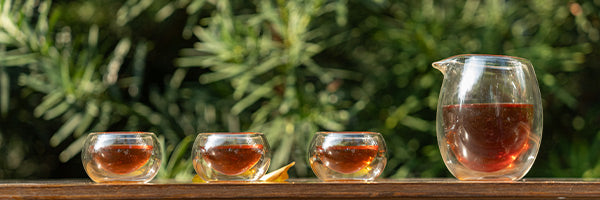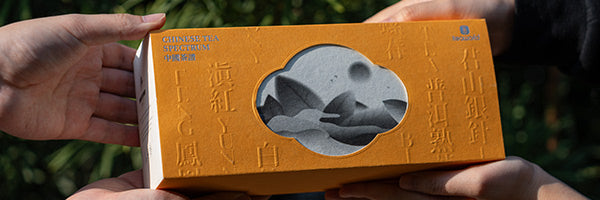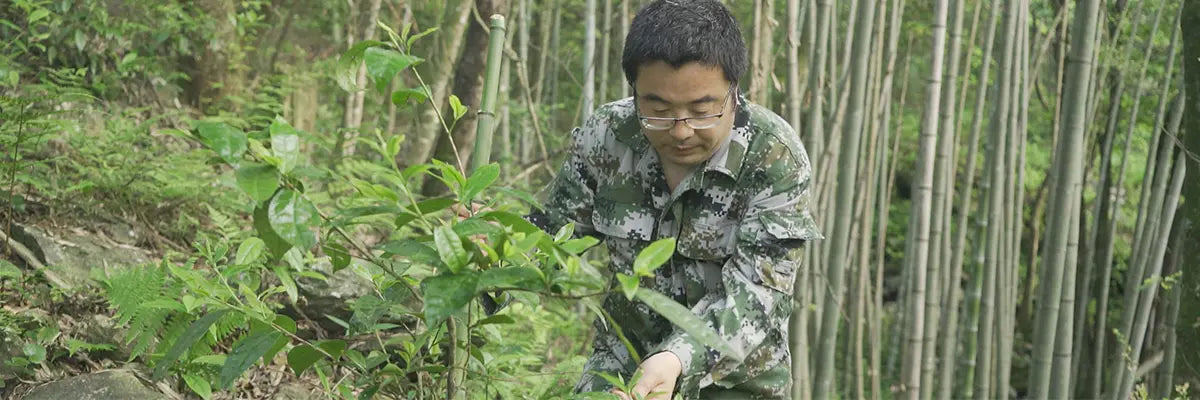What is Loose Leaf Oolong Tea?
Oolong tea, belonging to the category of semi-fermented tea, stands out as a distinctive type among China's six major tea categories. Known for its semi-fermented nature, Oolong tea offers a unique taste that combines the natural fragrance of green tea with the rich sweetness of black tea.
Oolong tea originated from the tribute tea "Longtuan" and "Feng Bing" during the Song Dynasty, evolving around the period of 1725 (during the Qing Yongzheng era). With a lingering fragrance and a sweet aftertaste, Oolong tea is suitable for people of all ages and genders. Beyond its delightful flavor, it is also believed to have certain medicinal properties, earning it the titles of "beauty tea" and "health tea." It is considered one of the best loose leaf tea.
The Origin of the Name "Oolong Tea"

In Fujian dialect, "Oolong" means "confused" or "bewildered."
Legend has it that a tea farmer, after harvesting fresh tea leaves on the mountainside, placed them in a bamboo basket and carried them downhill. The rough mountain path caused the basket to jostle, and the fresh tea leaves collided with each other, creating a floral fragrance reminiscent of flowers. The farmer, intrigued by this accidental discovery, incorporated it into tea processing, giving rise to a unique "shaking green" technique. At that time, lacking advanced scientific understanding, the farmer couldn't explain this mysterious phenomenon. Thus, this type of tea came to be known as "Oolong tea," meaning "confused tea." The term "Oolong Tea" became a common name for this category of tea.
Don't MIss Our Christmas Tea Sale, Buy 1 Get Free 1! >>>
Craftsmanship of Loose Leaf Oolong Tea
The production process of loose leaf oolong tea is relatively complex, primarily involving Weidiao(withering), Zuoqing(shaking and setting), Shaqing(killing green), Rounian (rolling), and baking processes. Among these, the Zuoqing process, known as "making green," is the key step that determines the distinctive characteristics of Oolong tea. It lays the foundation for the aroma and taste of Oolong tea and involves a complex and repeated process of shaking and setting.
Zuoqing refers to the process in which fresh tea leaves are repeatedly shaken in a suitable environment of temperature and humidity, causing them to collide and rub against each other. This results in gradual damage to the edges of the leaves, with some parts changing color due to a certain degree of oxidation. During the process of setting, the components inside the tea leaves undergo oxidation and transformation, emitting a natural floral and fruity fragrance. This process gives rise to the unique high floral aroma of Oolong tea, combining the flavor advantages of both black and green teas.
Primary Production Regions of Loose Leaf Oolong Tea

Loose-leaf Oolong tea is primarily produced in the southern regions of China, with four main production areas: Minbei (northern Fujian), Minnan (southern Fujian), Guangdong, and Taiwan.
In Minnan (southern Fujian), particularly known for its meticulous craftsmanship, the Oolong tea production is recognized for its emphasis on tightness in strip appearance and a diverse and colorful style. Minbei (northern Fujian) boasts a wide variety of Oolong tea types, numbering in the hundreds. Its distinctive feature lies in the emphasis on diverse varieties and meticulous roasting.
In terms of craftsmanship, Guangdong Oolong tea draws on the strengths of northern Fujian Oolong, establishing its unique approach with a focus on re-fermentation and repeated shaking. Compared to other Oolong teas, Guangdong Oolong tea seeks to capture the "mountain charm," with a particular emphasis on aroma. Taiwanese Oolong tea was introduced from Fujian during the Qing Dynasty and can be broadly categorized into two types: pouchong tea, with Wenshan pouchong being the most famous, and traditional Taiwanese Oolong tea, featuring renowned varieties such as Baihao Oolong and Dong Ding Oolong.
The Rich Aroma of Loose Leaf Oolong Tea
The aroma is the highlight of Oolong tea, offering a blend of the freshness found in green tea and the mature fragrance of black tea. It surpasses the fragrance of orchids, being both profound and enduring, with a rich and sharp intensity. It can be said that nearly any tea emitting a strong, distinct, and lingering aroma during brewing is almost certainly Oolong tea. The so-called "high and sharp fragrance" is distinctive enough to make one stop and appreciate. To fully experience the aroma of loose-leaf Oolong tea, one can purchase tea sampler, compare and taste various Oolong teas, and discover their preferred varieties.
For instance, Fenghuang Dancong possesses a natural and elegant floral fragrance (such as yellow branch, gardenia, almond, jasmine), accompanied by a unique mountain charm and honeyed sweetness. It has a rich, mellow, and refreshing taste. Baixiang Qilan has a clear and high fragrance, prominently featuring the aroma of orchids, with a taste that is mellow, refreshing, and delicate. Dongding Oolong has a natural floral fragrance with a hint of caramel, offering a rich and thick taste.
BUY OOLONG TEA SAMPLER AT CHINESE TEA SHOP>>>
Classic Loose Leaf Oolong Teas
1.Fenghuang Dancong

Fenghuang Dancong tea is a specialty of Chaozhou in Guangdong, originating from Fenghuang Town and named after the local Fenghuang Mountain. To enhance the quality of tea leaves, the town adopts the method of single-plant picking, single-plant tea making, and single-plant selling, with over ten thousand ancient tea trees utilizing this approach. Fenghuang Dancong tea is renowned for its four distinctions: beautiful shape, emerald color, rich aroma, and sweet taste.
2.Huangjin Gui
Also known as "Huangqin," Huangjin Gui is made from the tender leaves of the Huangqin tea tree. It is named for its golden-colored infusion and unique fragrance reminiscent of osmanthus flowers. Among existing Oolong tea varieties, Huangjin Gui is one of the earliest to sprout. The resulting Oolong tea boasts a high and uplifting fragrance, a mellow and sweet taste, earning it the reputation of "heavenly fragrance."
3.Da Hong Pao

Da Hong Pao is the foremost among the "Four Great Bushes" of Wuyi rock tea, with the highest quality and greatest renown, often referred to as the "Tea King." The tightly rolled leaves of Da Hong Pao exhibit a green-brown and lustrous color. The brewed tea has a clear and vibrant appearance, presenting a deep orange hue. The taste is distinctly rocky, rich, and refreshing, with a lingering fragrance at the bottom of the cup. The aroma is intense, long-lasting, and distant, accompanied by a subtle smokiness and occasional floral and fruity notes.
4.Yongchun Foshou
Yongchun Foshou is a historically renowned tea, said to have originated from grafting tea tree branches onto Buddha's hand citron plants. Buddha's hand citron is a fragrant and precious fruit, and the tea is named after it not only because its leaves closely resemble those of the citron but also because the dried tea leaves exude a unique fragrance reminiscent of the citron when brewed.
5.Zhangping Shuixian

Zhangping Shuixian is the only tightly compressed Oolong tea among its kind, making it exceptionally unique. It possesses a natural floral fragrance resembling orchids, with a taste that is mellow, refreshing, and delicately smooth. Able to withstand long-term storage and repeated infusions, the tea exhibits a reddish-yellow color. Upon closer tasting, the fragrance of narcissus flowers is evident, accompanied by a pleasant aftertaste and the characteristic of being stomach-friendly even with prolonged consumption.
6.TieGuanyin
The Anxi region is surrounded by hills, shrouded in mist, with an average annual temperature ranging from 15 to 18 degrees Celsius. The acidic red soil is deep, creating a unique geographical environment suitable for tea tree growth. Anxi Tieguanyin is a premium Oolong tea, widely acclaimed for its tightly curled tea leaves. Some leaves resemble fishhooks, while others take on the appearance of a dragonfly's head. As the moisture evaporates, a layer of white frost, known as "sand-green frost," forms on the leaves. The tea is highly popular, featuring a unique mountain charm and a distinct flavor profile.
7.Dong Ding Oolong
The core tea-producing region for Dong Ding Oolong is situated at an elevation of 600-1000 meters. The tea is harvested from high-altitude tea trees, including the Qingxin Oolong variety, and the lightly semi-fermented leaves are known as "Dong Ding Oolong." Characterized by tightly curled and twisted appearance, the tea leaves form a strip-like structure, displaying a dark green color. The taste is rich, mellow, and sweet, with a pronounced aftertaste and a strong returning sweetness. Dong Ding Oolong has the refreshing fragrance of osmanthus flowers, with the highest quality found in spring tea. Its vibrant color, high fragrance, and rich flavor have earned it a renowned reputation and widespread popularity.
8.Jinxuan Oolong
Jinxuan tea hails from Taiwan, China, and belongs to the category of lightly fermented Oolong tea. Produced from the newly cultivated tea tree known as "Tai Cha No. 12," Jinxuan Oolong possesses a unique variety fragrance, reminiscent of osmanthus or milk fragrance, with a particular reputation for its milk fragrance.
The Benefits of Loose Leaf Oolong Tea
Loose-leaf Oolong tea offers several benefits and effects, including refreshing and awakening, cholesterol reduction, antioxidant properties, etc.
1.Refreshing and Awakening
Oolong tea contains a significant amount of caffeine, which stimulates the central nervous system. Moderate consumption can help in refreshing and awakening the mind, as well as alleviating fatigue. Apart from Oolong tea, other loose leaf tea such as loose-leaf black tea and loose-leaf green tea also have notable refreshing and awakening effects.
2.Cholesterol Reduction
The unique properties of tea polyphenols in Oolong tea, particularly catechins, contribute to lowering cholesterol. These compounds bind with cholesterol in the digestive system, reducing its absorption from food. Additionally, they inhibit the body's synthesis of cholesterol, thus aiding in the reduction of blood lipid levels.
3.Antioxidant Properties
Loose-leaf Oolong tea is rich in antioxidants, including tea polyphenols, catechins, and theanine. These compounds help neutralize free radicals, slowing down the cellular aging process and protecting the body from the threats of chronic diseases.
Buy oolong tea at best tea shop >>>
Recommended Brewing Method for Loose Leaf Oolong Tea
The Gaiwan brewing method is a commonly used technique for Oolong tea, emphasizing high pouring and low sipping to maximize the release of tea aroma.

Carefully rinse the Gaiwan and tea utensils with boiling water to remove any odors and elevate the temperature of the Gaiwan. Depending on personal preference, add an appropriate amount of loose-leaf Oolong tea (recommended within 8g) into the Gaiwan. Pour water into the Gaiwan, adopting a circular pouring technique to allow the water to swirl along the inner wall of the Gaiwan. This ensures the gradual saturation of each tea leaf.
Generally, the first infusion can be poured out after 15-20 seconds, and the second infusion after 20-25 seconds. Increase the steeping time by approximately 5 seconds for each subsequent infusion. High-quality loose-leaf Oolong tea can be steeped for seven or more infusions.
Owing to its exceptional qualities, Oolong tea is suitable for daily consumption and makes a thoughtful and healthy gift, such as a Christmas tea gifts or New Year tea gifts. iTeaworld offers a variety of classic loose leaf Oolong teas and Oolong Tea Sampler, inviting you to explore the authentic taste of the most classic Oolong teas—a truly worthwhile experience.
With centuries of development, Oolong tea has evolved into a diverse range of varieties, each with its own unique characteristics. Especially with classic Oolong teas, each one features distinctive tea tree varieties and production processes. This article aims to unveil the beauty of Oolong tea, providing you with insights and discoveries. For a deeper understanding of the mysteries of Oolong tea, there's nothing better than personally tasting and comparing the flavors to appreciate the intriguing aspects fully.













